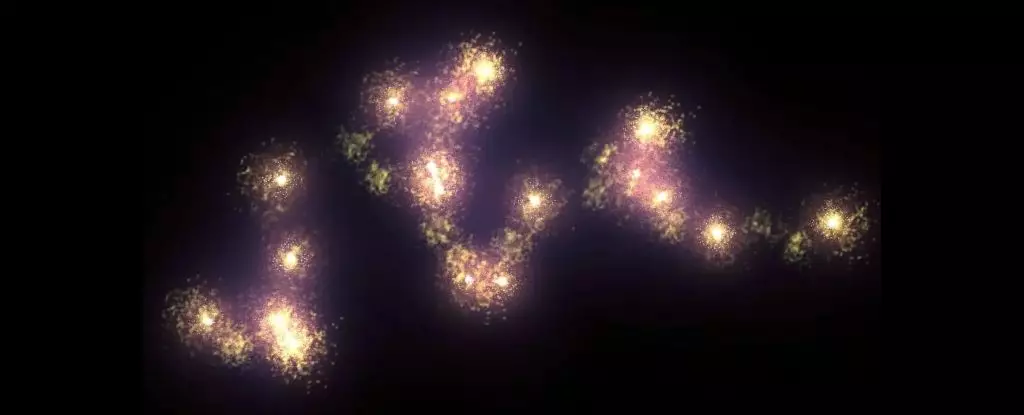In the universe’s vastness, where time and space intertwine in mysterious ways, the Hercules-Corona Borealis Great Wall stands as a monumental testament to the complexities of cosmic structures. Originally estimated to measure about 10 billion light-years in length, recent research suggests that this awe-inspiring galaxy cluster could extend up to 15 billion light-years, challenging our fundamental understanding of cosmic architecture. This re-evaluation sparks both intrigue and concern within the scientific community, as it unearths questions that delve deep into the nature of the universe itself.
The implications of this revelation are staggering; not only does it expand the catalog of known cosmic formations, but it also pushes the boundaries of the cosmological principle, which posits a uniform distribution of matter across the universe. The findings, which are awaiting publication, signify a critical moment for astronomers and physicists alike, forcing them to reassess long-standing theories that dictate the behavior of the cosmos.
Gamma-ray Bursts: Nature’s Cosmic Beacons
At the heart of this discovery are gamma-ray bursts (GRBs)—the universe’s most powerful explosions, often heralding catastrophic stellar events such as supernovae and neutron star collisions. These phenomena serve as cosmic beacons, illuminating the way for astronomers to navigate the dark expanses of space. The earlier classification of the Hercules-Corona Borealis Great Wall was based on an initial focus on concentrated GRB activity—a pattern that now appears far more extensive than previously imagined.
The study conducted by astronomers István Horváth, Jon Hakkila, and Zsolt Bagoly involved a meticulous analysis of 542 GRBs, utilizing their redshifts—a measurement correlated with the universe’s expansion. This research effectively maps the Great Wall’s boundaries, extending from redshift values of 0.33 to 2.43, manifesting a scale that exists merely as a porthole to the unfathomable proportions of the observable universe, which spans an impressive 93 billion light-years.
A Challenge to the Cosmological Principle
The striking findings regarding the Great Wall exacerbate the tension surrounding the cosmological principle. Traditionally, this principle conveys that the universe is homogeneous over vast distances. Yet, with structures of such gargantuan dimensions popping up, scientists must grapple with the notion that these ‘super-structures’ are not mere coincidences or statistical anomalies but rather fundamental components of the cosmos’ architecture.
As known massive structures like the Quipu and the Sloan Great Wall have already taken their place in astronomical discourse, the Great Wall’s size challenges researchers to reconsider what defines our universe’s structure. The potential emergence of a 15-billion-light-year wall challenges the very tenets of cosmology and ignites curiosity about the forces governing these colossal formations.
The Implications of Cosmic Scale
These groundbreaking revelations compel us to ponder the implications of such colossal formations on our understanding of cosmic evolution. What does the existence of the Hercules-Corona Borealis Great Wall reveal about the distribution of galaxies and matter in the universe? How might these structures have influenced the evolution of cosmic history?
While the full extent of these implications remains to be explored, it is crucial to acknowledge that such newfound cosmic structures challenge the prevailing narrative of the universe’s evolutionary timeline. The questions raised by the Great Wall’s expanded size beckon further inquiry, urging researchers to dissect the mechanisms responsible for clustering matter on such an impressive scale.
A New Frontier in Cosmic Research
As this research moves toward publication and captures the attention of the broader scientific community, it appears we may be standing on the precipice of an exhilarating frontier in cosmic research. The discoveries surrounding the Hercules-Corona Borealis Great Wall can be regarded as another stepping stone in humanity’s relentless pursuit of knowledge. They elevate our understanding of the universe while simultaneously revealing the vast chasms of the unknown that still exist.
With each revelation, we inch closer to comprehending our place in the cosmos and the unfathomable extent of its mystery. The data presented thus far, coupled with the promise of future studies, signify that the universe is far from a neatly packaged narrative. Instead, it unfolds like an intricate tapestry, woven from threads of cosmic phenomena and waiting to be fully unraveled. As scientists work tirelessly to decode the secrets of the Hercules-Corona Borealis Great Wall, we are reminded that the quest for knowledge is a journey without a destination, rich with the potential for groundbreaking discoveries.

